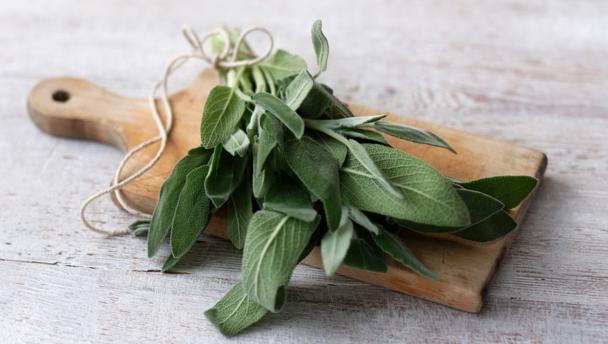

The colour of downy sage leaves and their flavour varies but, in essence, sage is a very strongly aromatic and slightly bitter herb that can withstand long cooking times without losing its flavour.
 Roast shoulder of lamb with herbs and honey
Roast shoulder of lamb with herbs and honey
 Rolled roast loin of pork with homemade apple sauce
Rolled roast loin of pork with homemade apple sauce
 Somerset chicken casserole with sage dumplings
Somerset chicken casserole with sage dumplings
 Slow roast leg of lamb with chardonnay, rosemary, sage and bay
Slow roast leg of lamb with chardonnay, rosemary, sage and bay
 Chicken breasts stuffed with sage and mustard
Chicken breasts stuffed with sage and mustard
 Pork, leek and apricot raised pie with cider and sage jelly
Pork, leek and apricot raised pie with cider and sage jelly
 Slow-cooked vegetables
Slow-cooked vegetables
 Butternut squash soup with parsley purée
Butternut squash soup with parsley purée
 Chestnut, leek and mushroom tartlets
Chestnut, leek and mushroom tartlets
 Sage and parmesan palmiers
Sage and parmesan palmiers
 Corn on the cob with burnt-onion ketchup
Corn on the cob with burnt-onion ketchup
 Butternut squash, sage and crème fraîche mash
Butternut squash, sage and crème fraîche mash
 Sage and onion stuffing balls
Sage and onion stuffing balls
 Adaptable sage, onion and sausage stuffing
Adaptable sage, onion and sausage stuffing
 Sage and onion tear and share bread
Sage and onion tear and share bread
 How to make beef stock
How to make beef stock
The strong flavour of sage means that a little goes a long way, especially if you're using dried leaves, so use sparingly. Sage goes well with pork, beef, duck and chicken recipes, and fatty meats in particular. In Italy it is commonly chopped, mixed with melted butter and served stirred into pasta or gnocchi. Fry sage leaves with liver or kidneys, or try dipping them into a light batter and deep-frying - they can be used to garnish dishes or eaten as a snack.
Type the ingredients you want to use, then click Go. For better results you can use quotation marks around phrases (e.g. "chicken breast"). Alternatively you can search by chef, programme, cuisine, diet, or dish (e.g. Lasagne).